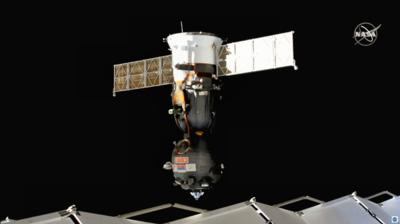Thu, Feb 11, 2021
Considering The Adding Of A Seat On The Spring Soyuz Mission to the ISS
A rotating crew of NASA and international astronauts have called the International Space Station home for more than 20 years. To ensure a consistent U.S. presence on the space station through the years, NASA has implemented safeguards to ensure crew transportation is always available.

NASA now is considering obtaining a supplemental seat on the upcoming spring Soyuz crew rotation mission for a NASA astronaut to add additional capability to the agency’s planning. The agency issued a public synopsis to identify all sources that potentially could provide the crew transportation service in the needed timeframe beyond the capability NASA already has in operation with the agency’s Commercial Crew Program.
NASA has been working with Boeing and SpaceX to provide safe and reliable crew transportation to and from the International Space Station. The recent success of NASA’s SpaceX Demo-2 mission and the launch and docking of the Crew-1 mission have been significant milestones in providing reliable transportation to the space station on American commercial spacecraft from American soil. The upcoming NASA’s SpaceX Crew-2 mission, as well as the second uncrewed flight test for Boeing’s Starliner demonstrate continued progress.
Securing an additional Soyuz seat assures the back-up capability of at least one U.S. crew member aboard the International Space Station in the event of a problem with either spacecraft. NASA is considering providing in-kind services for this supplemental crew transportation service, rather than an exchange of funds.

It has been NASA’s practice to fly mixed crews on spacecraft to ensure safe and continuous operations of the International Space Station. Due to operational constraints, crew members must fly to the station and return on the same spacecraft. The crew currently aboard the station (Kate Rubins and the Crew-1 astronauts) must return on Soyuz and Crew Dragon respectively in April/May. NASA’s SpaceX Crew-2 is expected to launch as planned April 20. However, if the mission launch is delayed or an event occurs while Crew-2 is in-orbit that requires a premature return, NASA risks not having a U.S. crew member aboard the International Space Station.
“At NASA, we have a phrase we use often – dissimilar redundancy. That’s NASA speak for saying we always have a back-up plan that ensures we have a path forward even if we encounter an issue with our initial approach,” said Robyn Gatens, acting director for the International Space Station at NASA Headquarters. “We look forward to the next crew rotation on NASA’s SpaceX Crew-2 mission, and we’re looking to ensure we can continue to maximize our use of the station and minimize any risk by flying a U.S. astronaut on the upcoming spring Soyuz by providing in-kind services.”
The space station has hosted 242 people and a variety of international and commercial spacecraft. Astronauts and cosmonauts have traveled to and from the orbiting laboratory in the Russian Soyuz spacecraft and NASA’s space shuttle until its retirement in 2011.
More News
Hold Procedure A predetermined maneuver which keeps aircraft within a specified airspace while awaiting further clearance from air traffic control. Also used during ground operatio>[...]
Altitude Readout An aircraft’s altitude, transmitted via the Mode C transponder feature, that is visually displayed in 100-foot increments on a radar scope having readout cap>[...]
Aero Linx: European Hang Gliding and Paragliding Union (EHPU) The general aim of the EHPU is to promote and protect hang gliding and paragliding in Europe. In order to achieve this>[...]
Also: Skydio Chief, Uncle Sam Sues, Dash 7 magniX, OR UAS Accelerator US Secretary of the Air Force Frank Kendall was given a turn around the patch in the 'X-62A Variable In-flight>[...]
"The need for innovation at speed and scale is greater than ever. The X-62A VISTA is a crucial platform in our efforts to develop, test and integrate AI, as well as to establish AI>[...]
 ANN's Daily Aero-Term (05.09.24): Hold Procedure
ANN's Daily Aero-Term (05.09.24): Hold Procedure ANN's Daily Aero-Term (05.06.24): Altitude Readout
ANN's Daily Aero-Term (05.06.24): Altitude Readout ANN's Daily Aero-Linx (05.06.24)
ANN's Daily Aero-Linx (05.06.24) Airborne-NextGen 05.07.24: AI-Piloted F-16, AgEagle, 1st 2 WorldView Sats
Airborne-NextGen 05.07.24: AI-Piloted F-16, AgEagle, 1st 2 WorldView Sats Aero-News: Quote of the Day (05.07.24)
Aero-News: Quote of the Day (05.07.24)




